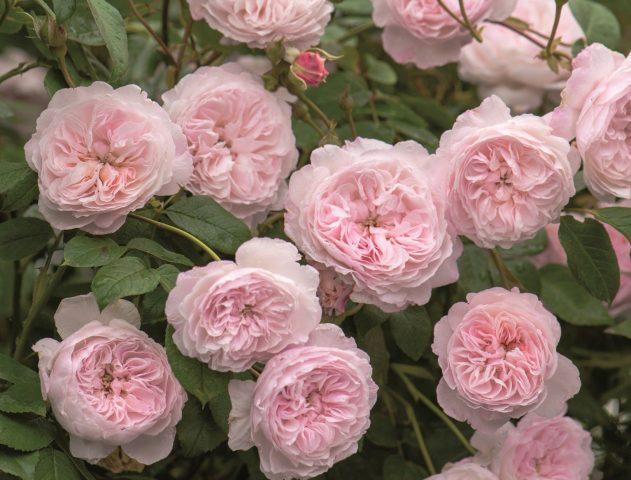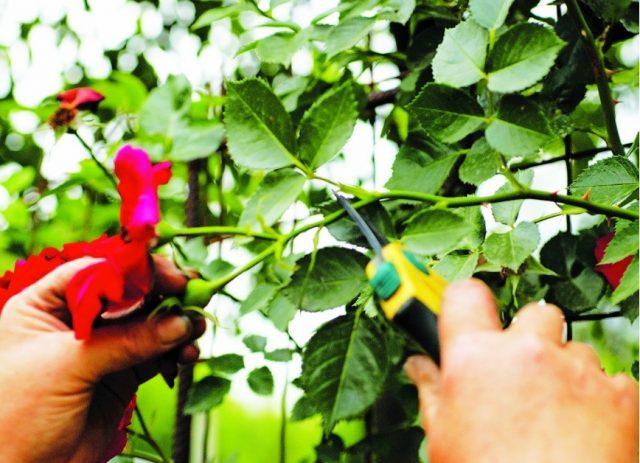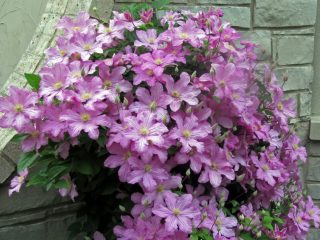Content
- 1 What does rose Rambler mean?
- 2 Breeding history
- 3 The best varieties of climbing rambler roses with photos
- 4 Advantages and disadvantages
- 5 Differences between Rambler and Climber climbing roses
- 6 Features of cultivation
- 7 Diseases and pests
- 8 Application in landscape design
- 9 Conclusion
- 10 Reviews of climbing roses ramblers
The rose has a special place in the garden. And, if earlier it was believed that this flower shrub was very capricious, then thanks to breeding technologies today you can choose any variety that meets the most stringent requirements. Hybrids are characterized by increased durability and at the same time vary in shape and shade. Rose Rambler is the result of crossing two types of flower crops and has pronounced decorative qualities.

Rose Rambler is used as a decoration for arches, gazebos and building facades
What does rose Rambler mean?
The word ramble translated from English means “to weave, curl, crawl.” This is how roses of the same name grow. The shrub plant easily entwines a nearby support, so it is used as a living decoration for facades, gazebos, arches and hedges. Rambler roses help hide imperfections in buildings and also perform a decorative function in landscape design.
A special feature of Ramblers is that their branches are thin and very flexible, and they grow up to 5-8 m in length. Due to the speed of growth and tenacity, the shrubs seem to wrap around the support they are near, which is why they are also called “climbing”.
Breeding history
Climbing roses were developed at the beginning of the 9th century as a result of crossing varieties of Japanese origin. The parent plants are considered to be the multi-flowered rose and the Wichuraiana rose. Hybrid varieties in most cases have a two-year shoot development cycle, with buds formed in large numbers, but their size does not exceed 8 cm. Ramblers from Multiflora roses acquired such abundant flowering.
The best varieties of climbing rambler roses with photos
A large number of varieties of climbing roses have been bred, but only certain species are popular among Russian gardeners. After all, the main criterion is resistance to unfavorable climatic conditions. Few Rambler climbing roses are perfect for the Moscow region, but it is worth highlighting such as:
- Albrighton;
- Red Rambler;
- Crimson Rambler;
- Goldfinch.
Albrighton
Rose Albrighton, whose full name is “The Albrighton Rambler,” was bred relatively recently, in 2013. The creator of the hybrid was the famous D. Austin, who gave the world many other popular varieties of roses.
The Albrighton hybrid is one of the rare species of Rambler roses that can bloom several times per season. The downside is that the flowering period is short and the buds remain on the branches in a loose state for only a few days.
The shrub is medium-sized, branches grow up to 4 m, there are few thorns.The buds are formed one by one, their shape is cup-shaped, rosette. The flower size varies from 4 to 5 cm in diameter. The shade is pink, sometimes cream. The smell is light, nutmeg.

Due to the intensity of growth, the Albrighton rose bush acquires moderate splendor with a diameter of up to 1.5 m
Rosa Red Rambler
Rose Red Rambler (Red Parfum) is a park climbing variety with red flowers. She was born in 1972 and is still considered one of the most beautiful. The hybrid got its name precisely because of the color of the buds, which are formed one by one. The diameter of the flowers is 7-8 cm. The aroma is faint and pleasant. Flowering is short-lived, but repeated.
The bush is small, its branches are up to 1.5 m long. The foliage is dark green, on which red flowers are clearly visible. The shrub reaches a width of up to 80 cm. It is used to decorate arched structures.

Red Parfum is characterized by high winter hardiness and good immunity to common diseases
Rosa Crimson Rambler
Rose Crimson Rambler was obtained in 1984. A special feature of the hybrid is its rapid development, which allows the bush to cover the entire support in a short time. The rose can reach a height of up to 4.5 m. It grows well on the south side, but also tolerates shading well.
Rose Crimson Rambler has pink flowers up to 5 cm in diameter, forming large inflorescences. The buds appear on the bush once, but remain open for a month. Flowering is abundant. There is no aroma.

In order for the Crimson Rambler rose to easily survive the winter, the bush should be covered
Goldfinch
Rose Rambler Goldfinch was born in 1903.In addition to the fact that this hybrid is considered the oldest among climbing varieties, it is also the first with bright yellow flowers. The downside is that the petals quickly fade under the influence of the sun, changing color from bright to cream.
The yellow climbing rose Rambler Goldfinch has a shrub height of up to 3 m. Flowers are formed from the very base of the shoots. They form large inflorescences of 10-25 buds. The branches are flexible and have virtually no thorns.

Due to its compactness, the Rambler Goldfinch rose can be grown not only as a climbing plant, but also as a wide shrub
Advantages and disadvantages
Rambler roses are a wonderful decoration for garden plots. Shrubs can easily hide landscape imperfections and create a cozy atmosphere.

Ramblers, despite their decorative appearance, are unpretentious in care
Pros:
- winter hardiness;
- good immunity to common diseases;
- abundant flowering;
- highly decorative;
- ease of care.
Minuses:
- the bush requires mandatory support;
- Many varieties bloom once.
Differences between Rambler and Climber climbing roses
Beginning gardeners often confuse climbing roses Rambler and Climber with each other. In fact, these two types of flower shrubs have clear differences:
- Ramblers' flowers are small in diameter, usually not exceeding 8 cm; Climbers, on the contrary, have buds that can grow up to 10 cm;
- Ramblers are distinguished by thinner and more flexible shoots, while Climbers have rigid and erect branches;
- Many varieties of Rambler roses bloom once, while Climbers can bloom again until mid-September.
Features of cultivation
Growing Rambler roses has a number of features, one of which is the mandatory presence of support.Also, when planting a young seedling, you should choose the right place. The shrub will take root well in an area where neutral or slightly acidic loam predominates. It is best to give preference to higher ground, since stagnation of water will quickly weaken the root system and begin to rot.
When planting near the wall of buildings or gazebos, a distance of at least 80 cm should be maintained. It is better to place the bushes themselves 1.5 m from each other.
Caring for Rambler roses involves timely watering. One adult shrub requires at least 20 liters of settled water. The irrigation schedule is drawn up depending on the climatic conditions of the region. As a rule, it is enough to moisten the soil once every two weeks. You should not water the rose more often, as this will provoke the formation of lateral surface roots. In this case, the main root will begin to suffer from a lack of moisture, which can lead to the death of the plant.
The flowering shrub responds well to feeding. In the first year after planting, the seedlings have enough nutrients in the soil; in the second year, they begin to apply fertilizers, alternating mineral and organic complexes. For the fourth and subsequent ones, only organic matter is enough.
Sampling is the most important operation, because the abundance of flowering depends on it. In the spring, sanitary cleaning of the bushes is carried out. Remove damaged and frozen shoots. In the fall, the most important pruning for Rambler roses is performed. It is carried out at the end of flowering, first removing faded shoots, then pruning young branches to the first strong bud.This will stimulate their further growth and increase the likelihood of abundant flowering.

In climbing shrubs, branches that spoil the appearance and interfere with the growth of other shoots should also be removed.
Diseases and pests
Climbing Rambler roses are distinguished by a large vegetative mass, so the shrub is susceptible to fungal diseases. Most often the plant suffers from powdery mildew and brown spot. With proper care, the bush is unlikely to become infected. But preventive measures should be constantly observed; for this, folk remedies are used - soap solution, infusion of tobacco or horsetail. If signs of infection are noticed, chemicals should be used.
Dangerous pests include green aphids and spider mites. To destroy them, insecticidal preparations are used, for example, Iskra-M.
Application in landscape design
In the landscape, Rambler roses are used to decorate the facades of buildings, gazebos and arched structures. Depending on the design, this decorative shrub can perform various functions, for example, to frame the entrance to the garden, highlight paths, or divide the area into zones. The only condition is the correct choice of support, since a massive bush will not fit with a thin arch or trellis, and the structure may tilt under the weight.
Even though most varieties bloom once, when decorating, you can create a composition of several hybrids with different flowering periods. They will replace each other throughout the growing season.
Conclusion
Rose Rambler is a luxurious shrub that can easily hide many imperfections in a garden plot.They are used as a decorative decoration for gazebos and arched structures, while the bushes themselves are undemanding and grow easily.
Reviews of climbing roses ramblers








